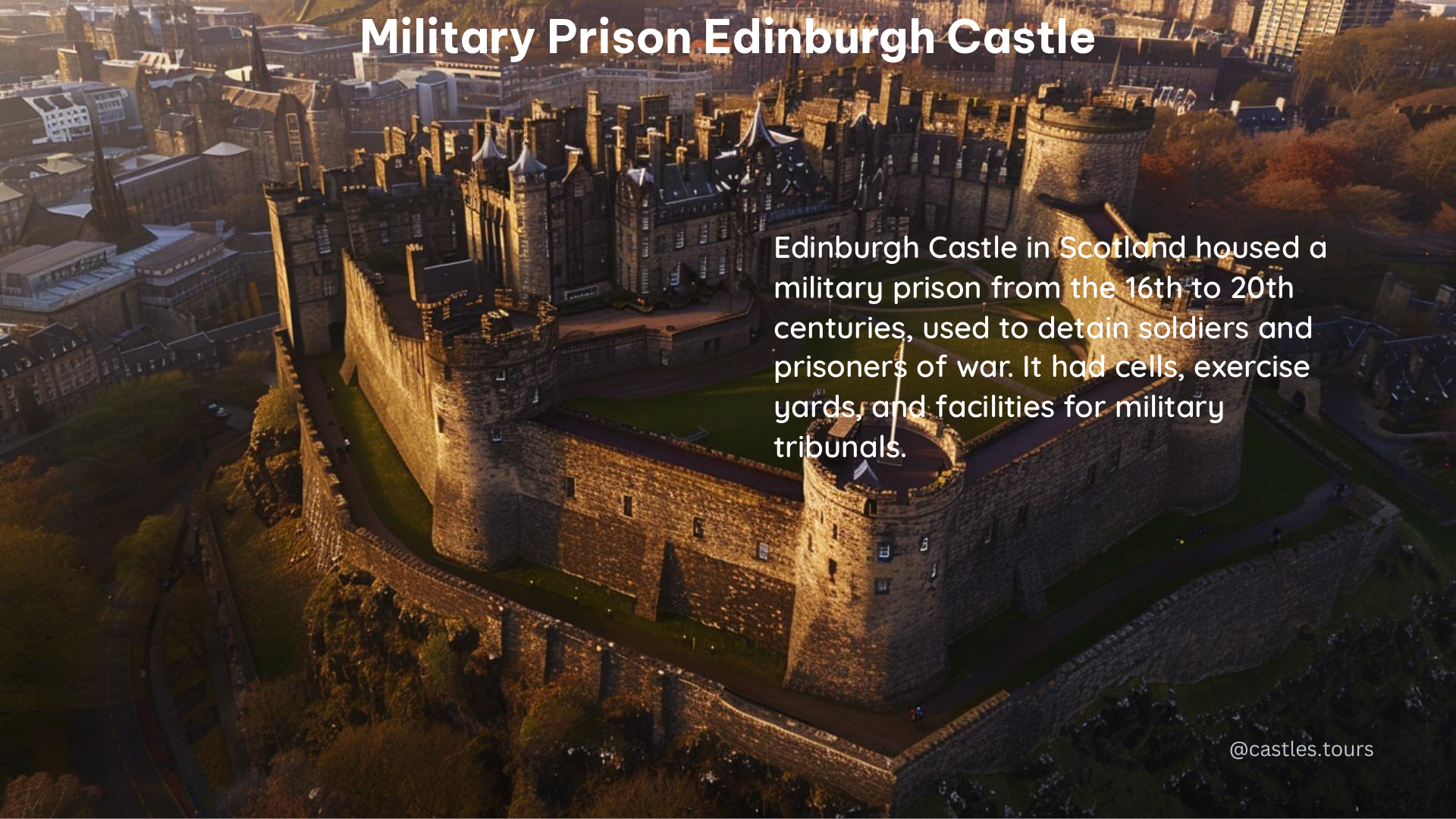The Military Prison at Edinburgh Castle stands as a testament to Scotland’s rich military history, offering visitors a unique opportunity to explore the captivating story of this iconic fortress. Built in 1842, this prison was designed to house soldiers from the local garrison, who would be held in solitary confinement for their transgressions.
The Establishment of the Military Prison
The Military Prison at Edinburgh Castle was established in 1842 to address the growing need for a dedicated facility to incarcerate soldiers from the nearby garrison. Prior to its construction, soldiers facing disciplinary action were often held in the castle’s dungeons or other makeshift holding areas, which were ill-suited for the purpose.
The decision to build a dedicated military prison was driven by several factors, including the desire to maintain strict discipline within the garrison and the need to provide a more humane and structured environment for the incarceration of soldiers. The new prison was designed with 12 individual cells, each equipped with separate ablution facilities, ensuring a level of privacy and sanitation that was not previously available.
The Architectural Design of the Military Prison

The Military Prison at Edinburgh Castle was designed with a focus on functionality and security. The building’s architecture reflects the practical needs of a prison, with a simple and utilitarian aesthetic that was common in penal institutions of the time.
The prison’s layout was organized around a central corridor, with the individual cells arranged along the sides. This design allowed for efficient supervision and control of the inmates, while also providing a degree of separation and privacy for each prisoner.
One of the most distinctive features of the Military Prison is the use of individual cells for solitary confinement. This approach was based on the belief that isolating prisoners would encourage reflection, repentance, and ultimately, rehabilitation. Each cell was equipped with a small window, providing natural light and ventilation, as well as a basic bed and furnishings.
Life Inside the Military Prison
The daily routine within the Military Prison at Edinburgh Castle was highly regimented and disciplined. Prisoners were expected to adhere to a strict schedule, with set times for meals, exercise, and other activities.
Meals were provided to the inmates, with a focus on simple, nutritious fare. The prison’s kitchen was located within the building, ensuring that the food was prepared on-site and served fresh to the prisoners.
Exercise and recreation were also an important part of the daily routine. Prisoners were allowed to spend time in a small exercise yard, where they could engage in physical activities and get some fresh air. However, this time was strictly supervised, and any infractions of the rules could result in further punishment.
Punishment and Discipline
The Military Prison at Edinburgh Castle was designed to be a place of strict discipline and punishment. Prisoners who violated the rules or failed to comply with the regime could face a range of punishments, including solitary confinement, reduced rations, or even corporal punishment.
One of the most severe forms of punishment used in the prison was the “black hole,” a small, dark cell where prisoners were kept in complete isolation for extended periods. This punishment was reserved for the most serious offenses and was intended to break the will of the prisoner and encourage compliance with the rules.
In addition to these physical punishments, prisoners could also face other forms of discipline, such as the loss of privileges or the denial of visitors. The goal of these measures was to instill a sense of remorse and a desire for rehabilitation in the prisoners, though the effectiveness of this approach has been the subject of much debate.
The Decline and Closure of the Military Prison
The Military Prison at Edinburgh Castle remained in operation for over a century, but by the mid-20th century, it had become increasingly outdated and ineffective. Changes in military justice and the growing emphasis on rehabilitation over punishment led to a gradual decline in the use of the prison.
In the 1960s, the decision was made to close the Military Prison and transfer its functions to other facilities. The building itself was then repurposed, with the cells and other spaces being converted for use as a museum and visitor attraction.
Today, the former Military Prison at Edinburgh Castle is a popular destination for visitors, offering a unique glimpse into the castle’s storied past and the harsh realities of military justice in the 19th and early 20th centuries.
Conclusion
The Military Prison at Edinburgh Castle stands as a powerful reminder of Scotland’s rich military history and the evolving approaches to discipline and punishment within the armed forces. Through its carefully preserved architecture and exhibits, the prison offers visitors a fascinating and thought-provoking experience, inviting them to reflect on the complex and often challenging realities of military life.
Whether you’re a history enthusiast, a castle aficionado, or simply someone with a curiosity about the past, a visit to the Military Prison at Edinburgh Castle is sure to leave a lasting impression.
Reference:
– Edinburgh Castle: Military Prison
– The Military Prison at Edinburgh Castle
– Edinburgh Castle: A History
